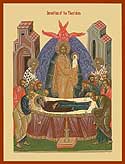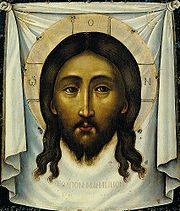|
|||
|---|---|---|---|
| This weekly bulletin insert complements the curriculum published by the Department of Christian Education of the Orthodox Church in America. This and many other Christian Education resources are available at http://dce.oca.org. | |||

The icon of the Dormition of the Theotokos shows the Mother of God lying on her deathbed. Jesus Christ, surrounded by angels, tenderly holds her luminous soul which in His glory He has taken to Himself. Her face is serene, and she is surrounded by the apostles. "Dormition" means "falling asleep." Saint Paul writes in I Thessalonians 4:13: "I do not want you to be ignorant concerning those who have fallen asleep, lest you sorrow as others do who have no hope." The icon of the Dormition shows the reason for hope. Death cannot have the final word, because Christ is taking His mother to heaven. The apostles are sad, but not prostrate with grief, because they know the fulfilled promise of the Lord. The angels in the icon show that those heavenly beings will be there for us, too. The hymns for the feast of the icon are also encouraging. The troparion and kontakion say that in her falling asleep, the Theotokos does not forsake the world but continues to pray for us. Just as Christ continues in His love for His mother, she is consistent in her loving concern for the world. Mark 14:58 reads: "I will destroy this temple that is made with hands, and in three days I will build another, not made with hands." This is the source of the title of the icon "Not Made by Hands." John's Gospel records that "the temple He was speaking of was His body. After His resurrection His disciples recalled what He had said, and they believed the Scripture and the words that Jesus had spoken" (John 2:20-1). There are a few stories of how the icon's image came to be. The one traditionally accepted by many sources is related in the "Prologue from Ochrid." We read that Prince Abgar of Edessa in Syria heard of Christ's miracles and healings. He sent a messenger to Palestine imploring Christ to come and heal his leprosy. Rather than leave Palestine, Christ gave Ananias a cloth on which He had wiped His face, leaving a perfect impression. When Abgar kissed it, most of the leprosy fell away, and later when he received baptism from the apostle Thaddeus he was completely healed. Abgar put the cloth in a gold frame and placed it at the entrance of the city of Edessa for people to venerate. Above it he wrote, "O Christ our God, everyone trusting in You shall not be put to shame." When a grandson of Abgar fell into idolatry, believers hid the image to keep it from destruction. Centuries later, with the city under Persian attack, the Theotokos told the Bishop or Edessa where to find the long-forgotten icon. 
He found it and processed around the city with it. The Persian army miraculously retreated. Once again, the Theotokos did not forsake the world. Once again, the world was given a healing, loving image of Christ, Who is "the image of the invisible God" (Colossians 1:15), the One who heals and loves us all. |
|||
